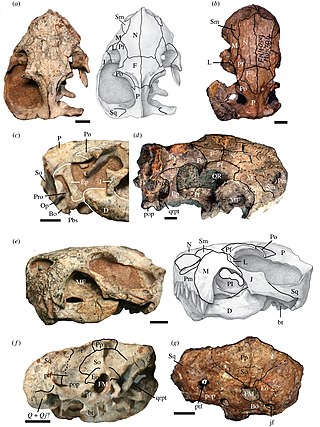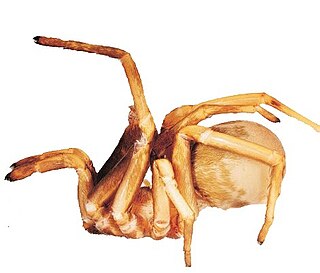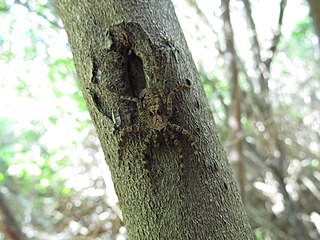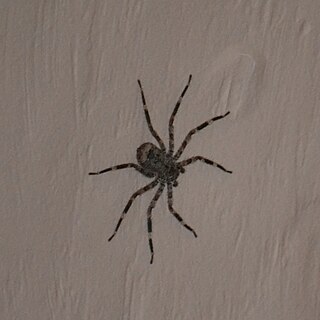
Oonopidae, also known as goblin spiders, is a family of spiders consisting of over 1,600 described species in about 113 genera worldwide, with total species diversity estimated at 2000 to 2500 species. The type genus of the family is OonopsKeyserling, 1835.

Selenopidae, also called wall crab spiders, wall spiders and flatties, is a family of araneomorph spiders first described by Eugène Simon in 1897. It contains over 280 species in nine genera, of which Selenops is the most well-known. This family is just one of several families whose English name includes the phrase "crab spider". These spiders are often called "Flatties" due to their flattened dorsal profile. The Afrikaans name for these spiders is "Muurspinnekop."

"How Long Is the Coast of Britain? Statistical Self-Similarity and Fractional Dimension" is a paper by mathematician Benoit Mandelbrot, first published in Science on 5 May 1967. In this paper, Mandelbrot discusses self-similar curves that have Hausdorff dimension between 1 and 2. These curves are examples of fractals, although Mandelbrot does not use this term in the paper, as he did not coin it until 1975. The paper is one of Mandelbrot's first publications on the topic of fractals.

The 4 arrondissements of the Réunion department are:
- Arrondissement of Saint-Benoît, with 6 communes. The population of the arrondissement was 126,777 in 2016.
- Arrondissement of Saint-Denis, with 3 communes. The population of the arrondissement was 204,304 in 2016.
- Arrondissement of Saint-Paul, with 5 communes. The population of the arrondissement was 214,073 in 2016.
- Arrondissement of Saint-Pierre, with 10 communes. The population of the arrondissement was 307,770 in 2016.

Pierre Benoit was a French novelist, screenwriter and member of the Académie française. He is perhaps best known for his second novel L'Atlantide (1919) that has been filmed several times.
Sadies is a genus of African jumping spiders that was first described by F. R. Wanless in 1984.

Euchambersia is an extinct genus of therocephalian therapsids that lived during the Late Permian in what is now South Africa and China. The genus contains two species. The type species E. mirabilis was named by paleontologist Robert Broom in 1931 from a skull missing the lower jaw. A second skull, belonging to a probably immature individual, was later described. In 2022, a second species, E. liuyudongi, was named by Jun Liu and Fernando Abdala from a well-preserved skull. It is a member of the family Akidnognathidae, which historically has also been referred by as the synonymous Euchambersiidae.

Graecopithecus is an extinct genus of hominid that lived in southeast Europe during the late Miocene around 7.2 million years ago. Originally identified by a single lower jaw bone bearing a molar tooth found in Pyrgos Vasilissis, Athens, Greece, in 1944, other tooth specimens were discovered from Azmaka quarry in Bulgaria in 2012. With only little and badly preserved materials to reveal its nature, it is considered as "the most poorly known European Miocene hominoids." The creature was popularly nicknamed 'El Graeco' by scientists.
Pleorotus was a monotypic genus of Seychelloise huntsman spiders containing the single species, Pleorotus braueri. It was first described by Eugène Louis Simon in 1898, and was endemic to the Seychelles. The description was based on a single male collected on Mahe Island in 1894, but none have been found in later collections, and it has been declared extinct.
Marie Benoît is a Belgian professional tennis player.

Sahastata is a genus of crevice weavers that was first described by Pierre L.G. Benoit in 1968.
Lathrothele is a genus of African spiders in the family Ischnothelidae. It was first described by Pierre L.G. Benoit in 1965.
Zyngoonops is a genus of Central African goblin spiders that was first described by P. L. G. Benoit in 1977.

Anyphops is a genus of wall spiders that was first described by P. L. G. Benoit in 1968.
Hovops is a genus of Malagasy wall spiders that was first described by P. L. G. Benoit in 1968.
Gastroxya is a genus of African orb-weaver spiders first described by Pierre L.G. Benoit in 1962.
Singafrotypa is a genus of African orb-weaver spiders first described by Pierre L.G. Benoit in 1962.

Anyphops rubicundus is a species of flattie spider in the Selenopidae family, within the genus Anyphops.









